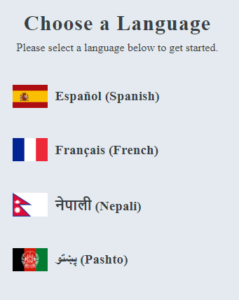- By Mark Nugent
- |
- Aug 16, 2024
Introduction to Language Funnels for Call Diversion Strategy
In today’s globalized world, businesses often cater to a diverse clientele speaking various languages. While this presents opportunities for growth, it also poses challenges for customer service, particularly within call centers. The traditional multilingual call center model, relying on agents fluent in multiple languages, can lead to long wait times, misdirected calls, and frustrated customers. Moreover, staffing and supporting such a model can be costly and resource intensive. TextingOnly provides translation texting solutions to fill this void.
Translation Texting Solutions
Translation texting solutions are tools or services that enable real-time or near-real-time translation of text messages between different languages, allowing for seamless communication across language barriers.
Enter language funnels, a strategic approach to call diversion that uses technology to streamline customer interactions in multilingual environments. Instead of relying solely on human agents to navigate language barriers, language funnels use automated systems to guide customers towards the right resources based on their language preferences. Using web-based click-to-text automation, customers start a text conversation upon landing on the website. Additionally, interstitial pages present language options before connecting customers to the right channels.
By intelligently routing customers and offering self-service options, language funnels offer significant benefits, including reduced wait times, improved customer satisfaction, optimized resource allocation, and cost savings.
Understanding Language Funnels
How Language Funnels Work
Setting up language funnels involves integrating technology solutions that enable automated language detection and routing. The process begins with web-based click-to-text automation instead of making a phone call. Upon clicking the “Text Us” or similar button, they will land on an interstitial page offering language options. Once the customer selects their preferred language, they seamlessly connect to a text-based interaction.
Interactive text responses (ITRs) play a crucial role in guiding customers through the language funnel. These pre-defined menus and prompts, tailored to different languages, allow customers to self-select the nature of their inquiry or issue. Based on their responses, customers interact with the relevant resources, such as knowledge bases, FAQs, or specific departments within the company.

Automation is key to the efficiency of language funnels. By overseeing routine inquiries and providing immediate access to information, automation frees up human agents to focus on more complex or sensitive issues that require personalized attention.
Benefits of Using Language Funnels for Call Diversion
The implementation of language funnels for call diversion yields a multitude of benefits for both businesses and customers:
- Reduced wait times: Customers can skip long hold times while waiting for an available agent who speaks their language. Language funnels offer immediate access to information and support, leading to faster resolutions and improved customer satisfaction.
- Improved customer satisfaction: By providing a seamless and personalized experience, language funnels show a commitment to meeting the needs of diverse customers. The ability to communicate in their preferred language enhances customer engagement and fosters loyalty.
- Optimized resource allocation: Language funnels enable businesses to distribute their human resources more strategically. By automating routine inquiries, language specific agents can focus on complex issues that require their ability, leading to increased productivity and efficiency.
- Cost savings: The automation of routine tasks through language funnels reduces the need for more staff, resulting in significant cost savings for businesses. Moreover, improved efficiency and reduced call volumes can lead to lower operational costs.
- Enhanced ability to oversee high text volumes: During peak times or promotional periods, language funnels can help manage increased inquiries without compromising service quality. The automated system manages inquiries simultaneously, ensuring that customers receive prompt help.
- Improved first-call resolution rates: By providing customers with immediate access to relevant information and resources, language funnels increase the likelihood of resolving issues on the first contact, leading to greater customer satisfaction, and reduced operational costs.
Implementing Language Funnels in Multilingual Organizations
Implementing language funnels requires planning and execution. Here are the key steps involved:
- Choose the right technology: Select a platform that offers robust language detection, interactive text response capabilities, and seamless integration with your existing systems.
- Create language-specific menus and responses: Develop clear and concise menus and prompts in each supported language, ensuring they are easy to understand and navigate.
- Train staff: Provide comprehensive training to your staff on the system and processes, using the translation tools for simple and efficient communication.
- Monitor and measure success: Track key metrics such as response times to texting, customer satisfaction surveys after a language funnel, and call reduction to evaluate the effectiveness of your language funnels.
- Refine and improve: Continuously analyze data and gather customer feedback to find areas for improvement and refine your language funnels for best performance.
By following these steps and using language funnels, multilingual organizations can update their customer service operations, saving time, resources, and enhancing the overall customer experience.
Contact us today to learn more about TextingOnly and schedule your free texting audit.